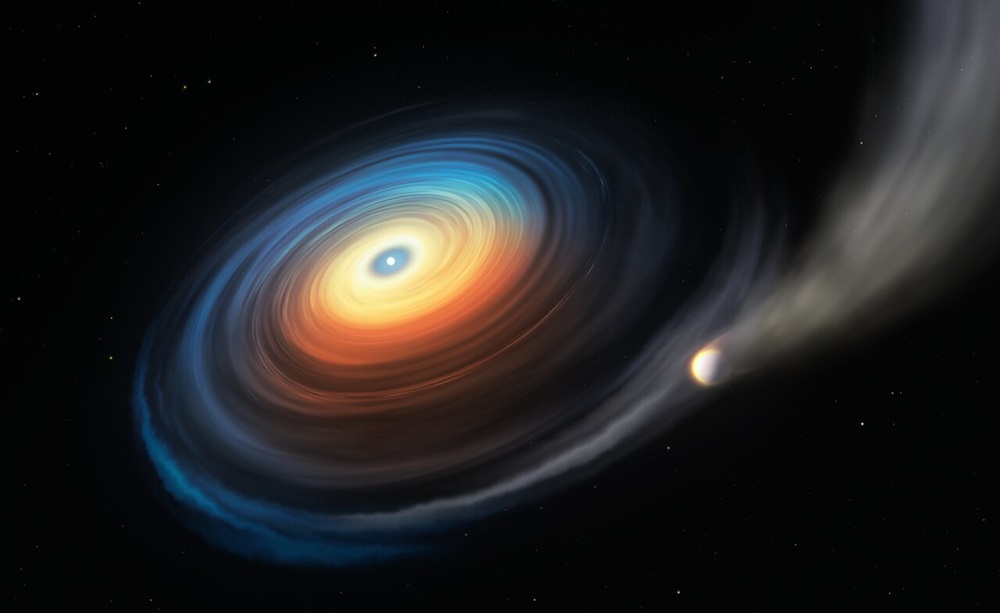Jupiter and Saturn may leave marks on the sun's corpse
White dwarfs could soak up clues about far-flung gas giants in their systems.

Alien scientists billions of years from now may detect traces of Jupiter, Saturn, Neptune and Uranus in our sun's corpse.
That's because the outer layers of superdense stellar remnants known as white dwarfs may often possess the remains of giant planets, a new study suggests.
White dwarfs are the Earth-size cores left behind after average-size stars have exhausted their fuel and shed their outer layers. Our sun will one day end up as a white dwarf, as will more than 90% of all stars in our Milky Way galaxy.
Related: Our Milky Way Galaxy: A Traveler's Guide (Infographic)
Initially, the white dwarf that will result from our sun about 8 billion years from now will still be a scorching 180,000 degrees Fahrenheit (100,000 degrees Celsius). The new study estimated that such a young, hot white dwarf will blast its surroundings with extreme ultraviolet radiation levels up to a million times greater than those that come from the present-day sun; this could last for a few million years.
The sun will likely destroy Earth and the other inner, rocky planets of the solar system as the star swells and dies, the disintegrated remains of these worlds polluting the resulting white dwarf. However, until now, it remained uncertain how giant planets in the outer reaches of a planetary system — worlds like Jupiter, Saturn, Uranus and Neptune — might fare under the extreme ultraviolet rays of a hot white dwarf.
"Nobody had looked into this part of the future of the solar system," study lead author Matthias Schreiber, an astrophysicist at the University of Valparaíso in Chile, told Space.com.
Breaking space news, the latest updates on rocket launches, skywatching events and more!
Previous research analyzed how alien stars could strip away the atmospheres of giant planets in close orbits. Schreiber and his colleagues adapted this work to examine the impact that hot white dwarfs might have on cold, giant planets.
The scientists found that giant planets far removed from hot white dwarfs could evaporate at rates comparable to those of giant planets orbiting near ordinary stars. This held true even if the giant planets were farther away from their hot white dwarfs than Pluto is from the sun.
Additionally, the researchers calculated how a young, hot white dwarf might look after it had accreted material that its extreme ultraviolet rays had stripped off giant planets. The scientists found that about one-third of known hot white dwarfs showed evidence of pollution from evaporating giant worlds. As such, "observing hot white dwarfs might help us to measure the abundances of gas-giant extrasolar planets," Schreiber said.
All in all, when it comes to our solar system, "the giant planets that will survive the evolution of the sun into a white dwarf will lose a small fraction of their atmospheres due to evaporation," Schreiber said. "The white dwarf will accrete a fraction of the evaporated material, and this will result in detectable signatures, so future generations of alien astronomers, if they exist, can potentially investigate the chemical composition of Jupiter, Saturn, Neptune and Uranus."
The scientists detailed their findings online Dec. 4, 2019, in The Astrophysical Journal Letters.
- Our Solar System: A Photo Tour of the Planets
- When Will the Sun Die?
- White Dwarfs: Compact Corpses of Stars
Follow Charles Q. Choi on Twitter @cqchoi. Follow us on Twitter @Spacedotcom and on Facebook.


Charles Q. Choi is a contributing writer for Space.com and Live Science. He covers all things human origins and astronomy as well as physics, animals and general science topics. Charles has a Master of Arts degree from the University of Missouri-Columbia, School of Journalism and a Bachelor of Arts degree from the University of South Florida. Charles has visited every continent on Earth, drinking rancid yak butter tea in Lhasa, snorkeling with sea lions in the Galapagos and even climbing an iceberg in Antarctica. Visit him at http://www.sciwriter.us
